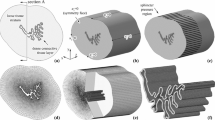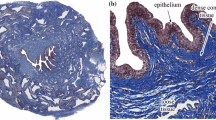Abstract
A novel artificial anal sphincter system has been developed to simulate the normal physiology of the human anorectum. With the goal of engineering a safe and reliable device, the model of human colonic blood flow has been built and the relationship between the colonic blood flow rate and the operating occlusion pressure of the anorectum is achieved. The tissue ischemia is analyzed based on constitutive relations for human anorectum. The results suggest that at the planned operating occlusion pressure of less than 4 kPa the artificial anal sphincter should not risk the vascularity of the human colon.
Similar content being viewed by others
References
Bisset, A.F., 2004. Artificial anal sphincter for faecal incontinence. Steer, 4(3):7.
Hajivassiliou, C.A., Carter, K.B., Finlay, I.G., 1997a. Biomechanical evaluation of an artificial anal sphincter prothesis. Journal of Medical Engineering & Technology, 21(3–4):89–95.
Hajivassiliou, C.A., Carter, K.B., Finlay, I.G., 1997b. Assessment of a novel implantable artificial anal sphincter. Diseases of the Colon & Rectum, 40(6):711–717. [doi: 10.1007/BF02140902]
Kloner, R.A., 1988. Introduction to the role of oxygen radicals in myocardial ischemia and infarction. Free Radical Biology and Medicine, 4(1):5–7. [doi:10.1016/0891-5849(88)90004-4]
O’Brien, P., Skinner, S., 2000. Restoring control: the acticon neosphincter artificial bowel sphincter in the treatment of anal incontinence. Diseases of the Colon & Rectum, 43(9): 1213–1216. [doi:10.1007/BF02237423]
Ortiz, H., Armendariz, P., DeMiguel, M., Ruiz, M.D., Alós, R., Roig, J.V., 2002. Complications and functional outcome following artificial anal sphincter implantation. British Journal of Surgery, 89(7):877–881. [doi:10.1046/j.1365-2168.2002.02137.x]
Patrício, J., Bernades, A., Nuno, D., Falcâo, F., Silveira, L., 1988. Surgical anatomy of the arterial blood-supply of the human rectum. Surgical and Radiologic Anatomy, 10(1):71–75. [doi:10.1007/BF02094074]
Rothbarth, J., Bemelman, W.A., Meijerink, W.J.H.J., Stiggelbout, A.M., Zwinderman, A.H., Buyze-Westerweel, M.E., Delemarre, J.B.V.M., 2001. What is the impact of fecal incontinence on quality of life. Diseases of the Colon & Rectum, 44(1):67–71. [doi:10.1007/BF02234823]
Satava, R.M., King, G.E., 1989. An artificial anal sphincter. Phase 2: implantable sphincter with a perineal colostomy. Journal of Surgical Research, 46(3):207–211. [doi:10. 1016/0022-4804(89)90057-7]
Shoshany, G., Pena, A., 1994. Evaluation of a silastic anorectal sphincter placed by the posterior sagittal approach in pigs. International Journal of Pediatric Surgical Science, 8:67–69.
Sofia, C.A., Rush, B.F., Koziol, J., Rocko, J.M., Seebode, J.J., 1988. Experiences with an artificial sphincter to establish continence in dogs. The American Surgeon, 54:390–394.
Tang, K., Huang, Z.J., Jin, T., Bao, R., Chen, G.B., 2007. Influence of input acoustic power on regenerator’s performance. Journal of Zhejiang University SCIENCE A, 8(9):1452–1456. [doi:10.1631/jzus.2007.A1452]
Uozaki, Y., Dihmis, W.C., Yamauchi, H., Moczar, M., Miyama, M., Pasteau, F., Tixier, D., Bambang, S.L., Loisance, D.Y., 2001. Intestinal tissue oxygenation and tumor necrosis factor-α release during systemic blood flow changes in pigs with left ventricular assist devices. Artificial Organs., 25(1):53–57. [doi:10.1046/j.1525-1594.2001.025001053.x]
Yan, G.Z., Zan, P., Ye, D.D., Liu, H., 2007. Design of Transcutaneous Energy Transmission System for Artificial Anal Sphincter. The 2007 IEEE International Conference on Mechatronics and Automation. Harbin, China, August 5–9, p.1434–1438.
Author information
Authors and Affiliations
Corresponding author
Additional information
Project (No. 20070248094) supported by the Ph.D Program Foundation for New Researchers of Ministry of Education of China
Rights and permissions
About this article
Cite this article
Zan, P., Yan, Gz. & Liu, H. Modeling of human colonic blood flow for a novel artificial anal sphincter system. J. Zhejiang Univ. Sci. B 9, 734–738 (2008). https://doi.org/10.1631/jzus.B0820099
Received:
Accepted:
Published:
Issue Date:
DOI: https://doi.org/10.1631/jzus.B0820099




